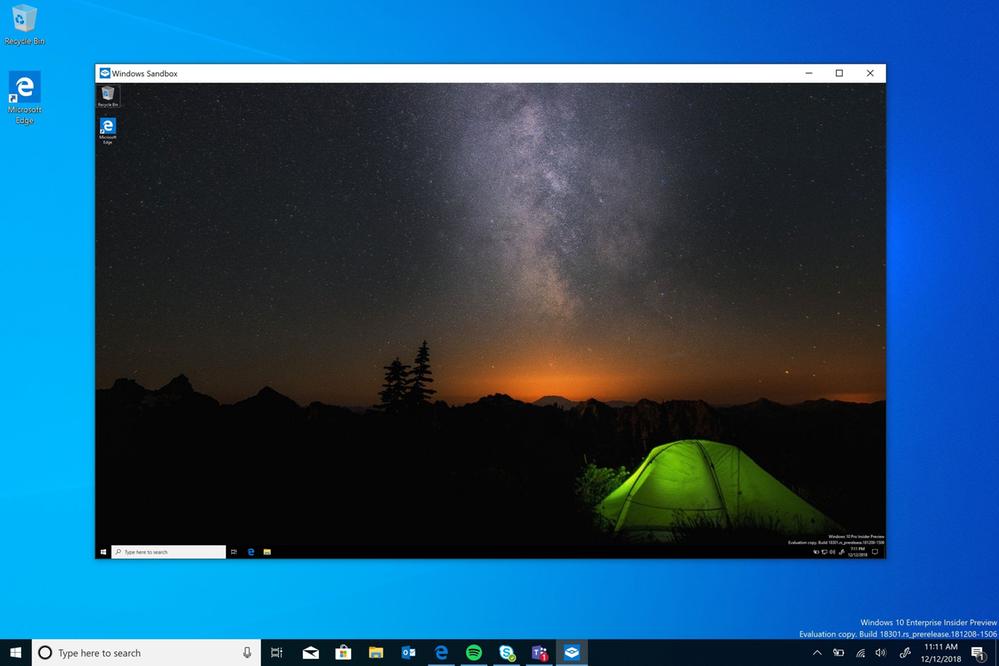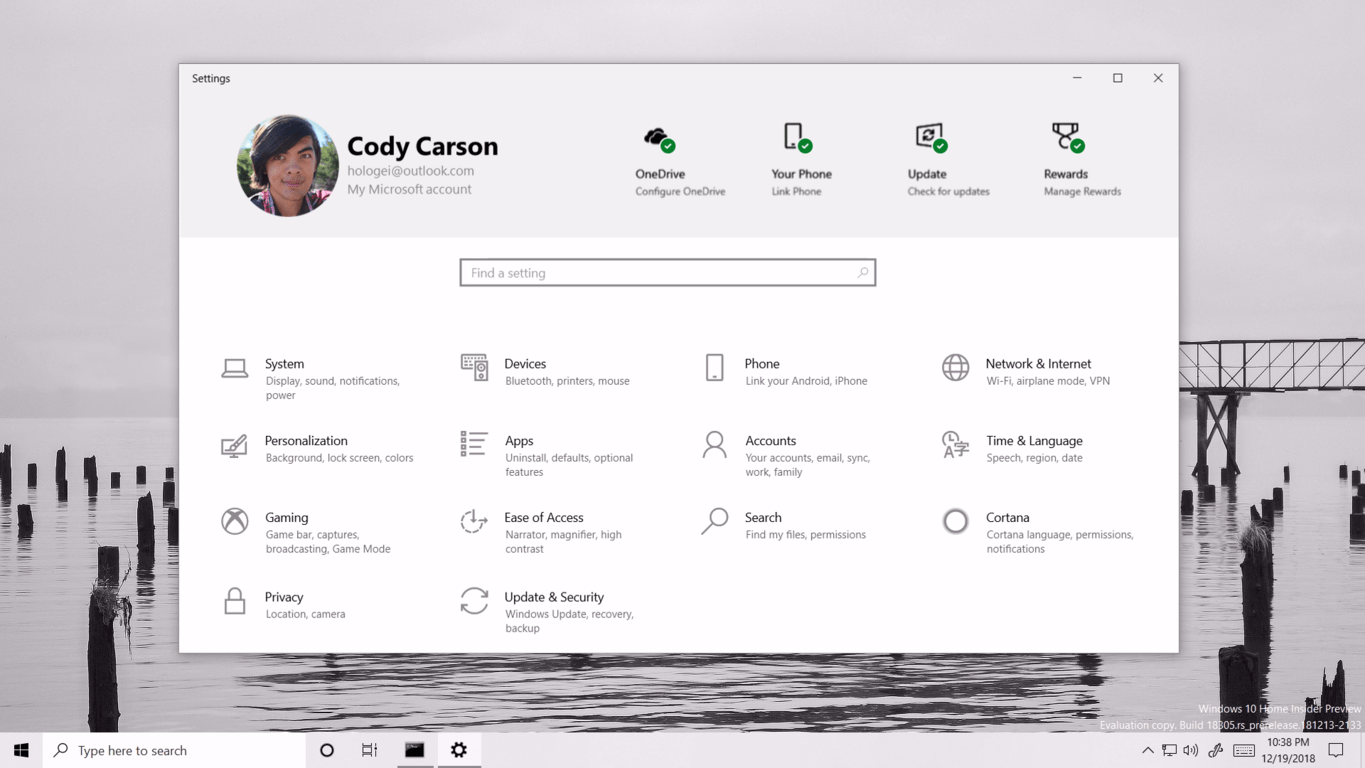Just in time for the holidays, the Windows Insider program leaves 2018 with an abundance of features for fast ring insiders to get their hands on. Build 18305 is the latest of these builds, and in conjunction with 18298, we’ll be taking a quick look at what’s new.
Start menu

Let’s start with Start. Builds 18305 and 18298 have made subtle adjustments to the customization experience of the Start Menu, featuring a new default layout which is more compact and organized. The Office apps and games have their own folders, which in a way makes them stand out more while making them less obtrusive. This layout is less distracting, making the few key apps that are pinned more appealing. Should you want to start over, right clicking on the titles of app groups will let you unpin them all at once.
Office app for Windows 10

A new app can be found prominently placed at the very top of this Start Menu: Office. The app’s design reflects Office.com’s layout, which according to Jared Spataro, Corporate VP for Microsoft 365:
“…more than 40 percent of Office 365 web users start their work by visiting Office.com.”
The at-a-glance overview displays all your office apps and recent documents in one place. This app will replace the My Office app, which was sort of nice but completely useless.
Cortana and Microsoft To-Do

In previous releases of Windows 10, users of the mail app may have noticed Microsoft To-Do alongside the Calendar and People shortcuts. This and today’s features in Cortana integration are part of a greater effort to integrate Microsoft To-Do into your Office 365 life. To-do, however, just like OneNote, is a free app that anyone can use without an Office Subscription. The To-Do app is not installed on your PC by default, rather, clicking on the shortcut will take you to it’s Microsoft Store page.
After you’ve installed the app and signed in using your Microsoft Account, the app should automatically sync with your Outlook tasks. To enable To-Do access in Cortana, you can open Connected Services in Cortana’s notebook. From here, Connect your Outlook or Office365 account. In build 18305, you can add to lists, recall from lists, and set reminders.
Symbols and Kaomoji in the emoji panel

Entering symbols beyond those on your keyboard can be a tricky task on a PC. Starting with build 18305, however, the emoji panel now has a section for Kaomoji and symbols, which can be opened using the keyboard shortcut Win+.
Windows Sandbox
 Windows Experience Blog
Windows Experience Blog
Scrolling through the items in my downloads folder, it’s apparent that I have a lot of non-Microsoft Store app installations on my PC, admittedly, some from questionable sources. I’m not alone in this scenario, there are a lot of professionals and tech enthusiasts who take to the internet looking for new tools or application plugins to assist their projects, but even from trusted sites, there always is the risk of an app going rogue or infecting your PC. For Windows 10 Pro and Enterprise, Windows Sandbox is a new, simple virtual desktop environment for testing apps safely in isolation from the rest of your PC.
Unlike creating a virtual Machine, everything needed to set up a Sandbox is included with Windows. You don’t need to download a VHD in order to set one up. A Sandbox is also temporary, completely resetting itself between sessions. All software and files from Sandbox sessions are permanently deleted from your PC.
If you use virtual machines, and Windows Sandbox sounds interesting to you, make sure to check out the Windows Sandbox post at the Windows Kernel Internals site. Sandbox, like many other Windows Features, is optional and available only to Pro and Enterprise users. It can be enabled at the same optional features page found in previous versions of Windows.
Windows Settings

The Windows Settings is being redesigned to reflect the layout of your Microsoft Account homepage online. Along the top, you’ll find your user account information, and shortcuts to some random user related things like OneDrive, Phone, and Rewards. As of right now, like many of the things in Insider releases as of late, not everyone will see these changes.
Windows Sign in
The Sign-in options under the Accounts section in the Windows Settings features a new design in the latest Insider fast builds. The layout is far more organized than the previous haphazard mess of titles toggles and buttons, organizing sign-in options under sections listed at the top of the page. There’s also a new section here for sign in via security key.
It’s now possible to create a password-less phone number account in Windows 10. By setting up a new user account in the Windows Settings, create a new account with your phone number. On the lock screen, the new user account will be listed as your phone number, which you can sign into by clicking sign in options, and PIN. You will then be guided through the steps to set up that account. Instead of needing a password, the account can be secured with a PIN, Windows Hello, or whatever else.
If you happen to forget your PIN, a new PIN reset experience will open. The design of this page reflects what you would find on the web.
Ease of Access
Launching the Narrator in the latest Windows Insider builds launches an updated Narrator Home. From here, you can access and configure the narrator to your liking. You may also explore all the new Narrator features under the “What’s New” section.
Also in the Windows Settings under ease of access, there are new options which can change the size appearance of the cursor and pointer. It’s a little confusing because there are now two places in the Windows Settings for accessing pointer options. One for customization, and the other for accessibility. It’ll be interesting to see how Microsoft handles that.
Be Careful
Windows Insiders should spend a few minutes when they encounter a new bug investigating it so they can provide more useful feedback about its occurrence. Check the Feedback Hub for Known Issues with your build under the announcements, and search existing feedback to make sure your issue hasn’t already been posted. Being more organized as a Windows Insider goes a long way to focusing on the issues that matter most.
These builds can be unstable, and may still harbor bugs that can cause frustration or bog down your device. Be careful and think twice about installing them on a device you rely on for something important. Many of the features I’ve discussed will reach a Windows Update available to the general public in the future.
https://www.onmsft.com/news/hands-on-windows-10-insider-preview-build-18305-videoBagikan Berita Ini















0 Response to "Hands-on: Windows 10 Insider Preview Build 18305 (video) - OnMSFT"
Post a Comment